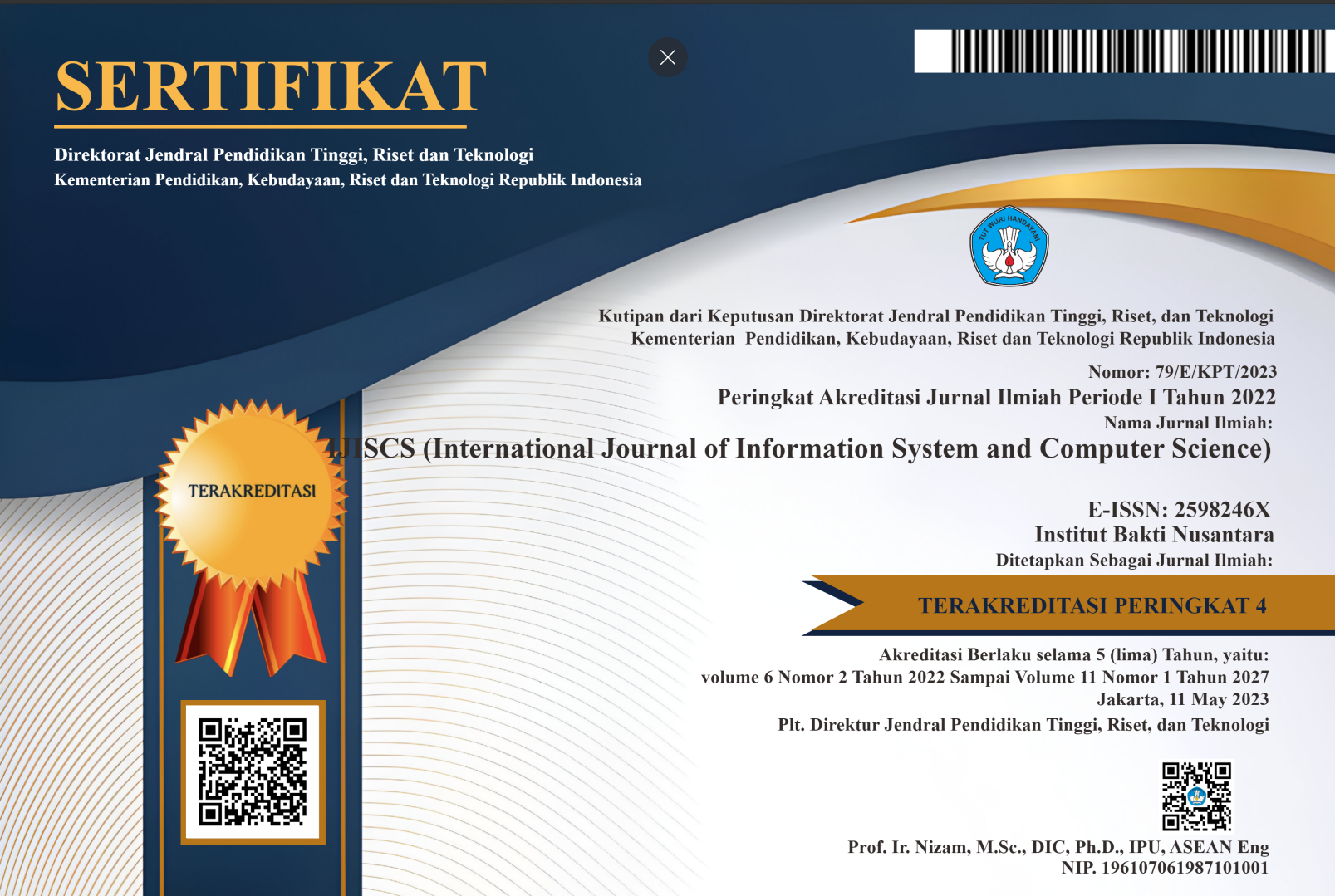THE C45 ALGORITHM METHOD IN PREDICTING DAMAGED GOODS CASE STUDY: SEMULI RAYA INDOMARET SHOP
(1) Information System, ITBA Dian Cipta Cendikia Kotabumi, North Lampung
(2) Technology Computer, ITBA Dian Cipta Cendikia Kotabumi, North Lampung
(3) Technology Computer, ITBA Dian Cipta Cendikia Kotabumi, North Lampung
 Corresponding Author
Corresponding Author
Abstract
Indomaret Semuli Raya is a company that competes in the industrial world. In the industrial world, the quality of products marketed is an important indicator for Indomaret Semuli Raya to be able to stand during intense competition from other companies. Product quality is certainly the thing that attracts consumers. In dealing with problems that occur in the company, it must make the right decision in determining the product strategy to be sold, to get the right decision, sufficient item data is needed to be analyzed. This research raises the issue of whether or not goods are worth selling in the category of damaged goods at Indomaret Semuli Raya in the period from February to March 2023. Data mining is used in this study, specifically the C4.5 Algorithm Method. The author chose the C4.5 Algorithm method because it can be used to determine whether or not damaged goods are unfit for sale. Algorithm C4.5 will determine damaged goods based on the attributes that become the standard for the eligibility of goods. The attributes referred to in this study are Overweight, Brackage, Sell by, and Moisture and temperature. The aftereffects of manual computations by means of Microsoft Succeed utilizing the C4.5 Calculation have a precision of 90.00% then demonstrated by the RapidMiner application with an exactness of 90.00%.
Keywords
References
M. T. Informatika and U. Amikom, “Analisis Pembobotan Kata Pada Klasifikasi Text Mining,” vol. 3, no. 2, pp. 179–184, 2019.
I. Technology and C. Science, “No Title,” vol. 4, pp. 20–29, 2021.
H. Annur, “Klasifikasi Masyarakat Miskin Menggunakan Metode,” vol. 10, pp. 160–165, 2018.
I. A. Nikmatun, U. Diponegoro, I. Waspada, and U. Diponegoro, “Implementasi Data Mining Untuk Klasifikasi Masa Studi Mahasiswa Menggunakan Algoritma K-Nearest Neighbor,” vol. 10, no. 2, pp. 421–432, 2019.
A. F. Cahyanti, “Penentuan Model Terbaik pada Metode Naive Bayes Classifier dalam Menentukan Status Gizi Balita dengan Mempertimbangkan Independensi Parameter,” vol. 4, no. 1, pp. 28–35, 2015.
R. Yusri, S. Edriati, and R. Yuhendri, “Rangkiang : Jurnal Pengabdian Pada Masyarakat UP3M STKIP PGRI Sumatera Barat Rangkiang : Jurnal Pengabdian Pada Masyarakat UP3M STKIP PGRI Sumatera Barat,” vol. 2, no. 1, pp. 32–37, 2020.
N. Zumel and J. Mount, “Practical Data Science with R.”
N. Pati, “Algoritma C4 . 5 Untuk Penjurusan Siswa SMA,” pp. 3–6.
S. V. O. L. I. No, O. Algoritma, C. Klasifikasi, and P. P. Jantung, “No Title,” vol. I, no. 1, pp. 26–36, 2014.
A. I. Waspah et al., “Expectation Maximization Algorithm Memprediksi Penjualan Susu Murni Pada PT . Sewu Primatama Indonesia Lampung,” vol. 7, no. 1, pp. 27–38, 2022.
C. Algorithm et al., “Classification and Clustering of Internet Quota Sales Data Using,” vol. 9, no. 2, pp. 268–283, 2023, doi: 10.26555/jiteki.v9i2.25970.
E. V. Astuti and R. Mawarni, “The Comparison Using Expectation- Maximization Algorithm And C4 . 5 Algorithm To Predict The Result Of Biogas Production As A Power Plant At Pt Budi Starch & Sweetener ( BSSW ),” pp. 186–198.
A. P. Wibawa, M. Guntur, A. Purnama, M. F. Akbar, and F. A. Dwiyanto, “Metode-metode Klasifikasi,” vol. 3, no. 1, pp. 134–138, 2018.
J. Media and I. Budidarma, “Data Mining Menggunakan Algoritma K-Nearest Neighbor Dalam Menentukan Kredit Macet Barang Elektronik,” vol. 5, pp. 1063–1067, 2021, doi: 10.30865/mib.v5i3.3100.
D. S. Seruni, M. T. Furqon, and R. C. Wihandika, “Sistem Prediksi Pertumbuhan Jumlah Penduduk Kota Malang menggunakan Metode K-Nearest Neighbor Regression,” vol. 4, no. 4, pp. 1075–1082, 2020.
Article Metrics
Abstract View : 233 times
: 233 times Download : 120 times
Download : 120 times
DOI: 10.56327/ijiscs.v7i2.1515
Refbacks
- There are currently no refbacks.






